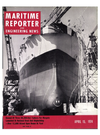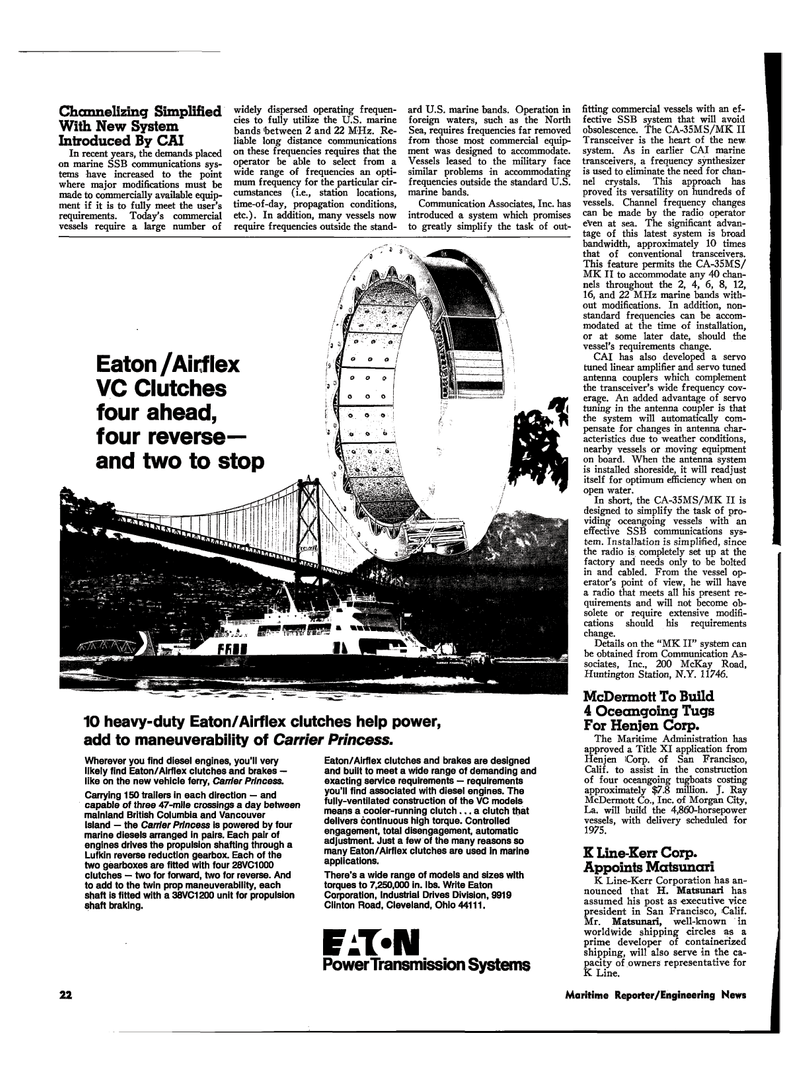
Page 20: of Maritime Reporter Magazine (April 15, 1974)
Read this page in Pdf, Flash or Html5 edition of April 15, 1974 Maritime Reporter Magazine
Channelizing Simplified
With New System
Introduced By CAI
In recent years, the demands placed on marine SSB communications sys- tems have increased to the point where major modifications must be made to commercially available equip- ment if it is to fully meet the user's requirements. Today's commercial vessels require a large number of widely dispersed operating frequen- cies to fully utilize the U.S. marine bands 'between 2 and 22 MHz. Re- liable long distance communications on these frequencies requires that the operator be able to select from a wide range of frequencies an opti- mum frequency for the particular cir- cumstances (i.e., station locations, time-of-day, propagation conditions, etc.). In addition, many vessels now require frequencies outside the stand- ard U.S. marine bands. Operation in foreign waters, such as the North
Sea, requires frequencies far removed from those most commercial equip- ment was designed to accommodate.
Vessels leased to the military face similar problems in accommodating frequencies outside the standard U.S. marine bands.
Communication Associates, Inc. has introduced a system which promises to greatly simplify the task of out- fitting commercial vessels with an ef- fective SSB system that will avoid obsolescence. The CA-35MS/MK II
Transceiver is the heart of the new system. As in earlier CAI marine transceivers, a frequency synthesizer is used to eliminate the need for chan- nel crystals. This approach has proved its versatility on hundreds of vessels. Channel frequency changes can be made by the radio operator even at sea. The significant advan- tage of this latest system is broad bandwidth, approximately 10 times that of conventional transceivers.
This feature permits the CA-35MS/
MK II to accommodate any 40 chan- nels throughout the 2, 4, 6, 8, 12, 16, and 22 MHz marine bands with- out modifications. In addition, non- standard frequencies can be accom- modated at the time of installation, or at some later date, should the vessel's requirements change.
CAI has also developed a servo tuned linear amplifier and servo tuned antenna couplers which complement the transceiver's wide frequency cov- erage. An added advantage of servo tuning in the antenna coupler is that the system will automatically com- pensate for changes in antenna char- acteristics due to weather conditions, nearby vessels or moving equipment on board. When the antenna system is installed shoreside, it will readjust itself for optimum efficiency when on open water.
In short, the CA-35MS/MK II is designed to simplify the task of pro- viding oceangoing vessels with an effective SSB communications sys- tem. Installation is simplified, since the radio is completely set up at the factory and needs only to be bolted in and cabled. From the vessel op- erator's point of view, he will have a radio that meets all his present re- quirements and will not become ob- solete or require extensive modifi- cations should his requirements change.
Details on the "MK II" system can be obtained from Communication As- sociates, Inc., 200 McKay Road,
Huntington Station, N.Y. 11746.
McDermott To Build 4 Oceangoing Tugs
For Henj en Corp.
The Maritime Administration has approved a Title XI application from
Henjen Corp. of San Francisco,
Calif, to assist in the construction of four oceangoing tugboats costing approximately $7.8 million. J. Ray
McDermott Co., Inc. of Morgan City,
La. will build the 4,860-horsepower vessels, with delivery scheduled for 1975.
K Line-Kerr Corp.
Appoints Matsunari
K Line-Kerr Corporation has an- nounced that H. Matsunari has assumed his post as executive vice president in San Francisco, Calif.
Mr. Matsunari, well-known in worldwide shipping circles as a prime developer of containerized shipping, will also serve in the ca- pacity of owners representative for
K Line.
Eaton /Airflex
VC Clutches four ahead, four reverse— and two to stop 10 heavy-duty Eaton/Airflex clutches help power, add to maneuverability of Carrier Princess.
Wherever you find diesel engines, you'll very likely find Eaton/Airflex clutches and brakes — like on the new vehicle ferry, Carrier Princess.
Carrying 150 trailers in each direction — and capable of three 47-mile crossings a day between mainland British Columbia and Vancouver
Island — the Carrier Princess is powered by four marine diesels arranged in pairs. Each pair of engines drives the propulsion shafting through a
Lufkin reverse reduction gearbox. Each of the two gearboxes are fitted with four 28VC1000 clutches — two for forward, two for reverse. And to add to the twin prop maneuverability, each shaft is fitted with a 38VC1200 unit for propulsion shaft braking.
Eaton/Airflex clutches and brakes are designed and built to meet a wide range of demanding and exacting service requirements — requirements you'll find associated with diesel engines. The fully-ventilated construction of the VC models means a cooler-running clutch ... a clutch that delivers continuous high torque. Controlled engagement, total disengagement, automatic adjustment. Just a few of the many reasons so many Eaton/Airflex clutches are used in marine applications.
There's a wide range of models and sizes with torques to 7,250,000 in. lbs. Write Eaton
Corporation, Industrial Drives Division, 9919
Clinton Road, Cleveland, Ohio 44111.
Power Transmission Systems 22 Maritime Reporter/Engineering News

 19
19

 21
21
